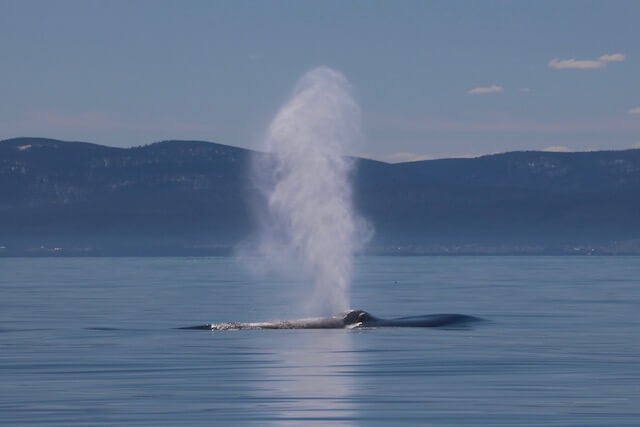“My first whale for 2019!” exclaims a whale-watching outfitter in the Gaspé Peninsula. His first observation was made through his daughter’s kitchen window on March 31. While taking a break in their home renovations, father and daughter gaze out at Gaspé Bay in Cap-aux-Os, a village completely surrounded by Forillon National Park. In the middle of the bay appears a spout, which is quickly swept away by the wind. For half an hour, the fast-moving whale surfaces every four minutes or so. It even comes to within 1 km of the coast, allowing the observers to confirm their initial guess: it’s a blue whale.
“I missed it! I’ve seen good numbers of harbour seals out on the ice in recent days, but no whales,” says an innkeeper from Cap-aux-Os, surprised that he hadn’t spotted the blue whale opposite his village. Watching wildlife, especially cetaceans, requires a good eye, but it’s also a question of looking at the right place at the right time. Blue whales spend an average of 5% of their life at the surface. With dive times of up to 30 minutes and an average swimming speed of 20 km/h, a blue whale seen in one place may reappear a considerable distance away during its next respiratory sequence.
Two days earlier, on the other side of the peninsula, in Cap-des-Rosiers, the attention of one observer is caught not by a sunset, but by a massive silhouette. She hurries over to her telescope to observe the animal producing such a spout. The mottled grey-blue back and protruding blowhole leave no room for doubt: it’s a blue whale.
Six species of cetaceans frequent the waters around Forillon National Park: minke whale, white-sided dolphin, humpback whale, harbour porpoise, fin whale and blue whale. Pilot whales are also observed on occasion. The surrounding waters are rich in prey for whales thanks to the inflow of minerals from three rivers that empty into the salt water and thanks to the Gaspé current.
In Charlevoix, between Anse à Bellevilleand Port-au-Persil, two white backs flash in the late afternoon light. “I think one of them is Pascolio” says the observer. “Every year at this time, I see this beluga with the deformed back.” Indeed, Pascolio has a major spinal deformity. This female beluga has been known to the GREMM team since 1985. She was adopted by Tadoussac business owners in 1990 through the Adopt a Belugaprogram. But Pascolio is not the only one whose back resembles a peanut shell. Belugas Néoand Scolio, among others, also exhibit this deformity. There is even a blue whale with a deformed back: Chameau.





